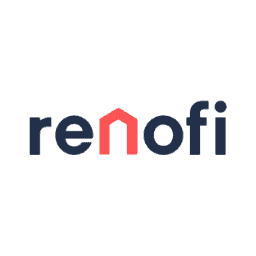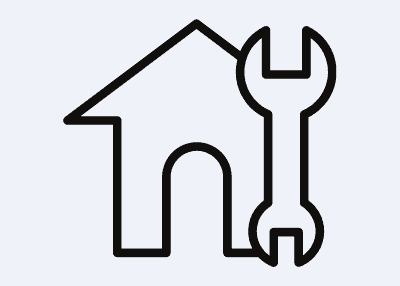RenoFi offers innovative home renovation loan solutions to current and prospective homeowners.
What is RenoFi?
RenoFi is a home renovation financing service. Founded by Justin Goldman, Lee Miller, and Rob Shedd, the platform connects homeowners with lenders who can provide flexible funding options.
Should You Use RenoFi to Finance Your Home Renovation?
RenoFi offers a unique alternative to funding home renovation projects, which makes them worth considering. RenoFi calculates your projected after renovation home value based on a unique type of appraisal to determine the loan amount – instead of using the equity you currently have available in your home.
Home inspections and draws aren’t required after loan approval; the credit unions in the RenoFi partner network assess lower interest rates and fees than you’ll find with traditional banks. So, upon approval for a loan, you can borrow with confidence knowing the lender won’t assess the steep interest rates and fees you’ll find with traditional banks.
How RenoFi Loans Work
How Much You Can Borrow
You can borrow up to 80% of your home’s value once the renovation is complete or 125% of your home’s current value. When reviewing your application, lenders also factor in your outstanding mortgage balance and financial health.
Loans are limited to $500,000, but any loan amount over $250,000 may have more stringent qualification criteria. Use the personalized Loan Calculator on RenoFi’s website to gauge how much you can afford to borrow. It only takes a few minutes, and there is no formal credit check.
What You Can Use RenoFi Loan For
You can use the RenoFi Loan products to renovate a home you currently own or plan to buy. However, loan proceeds cannot be used on investment properties, homes currently listed for sale, new construction, or multi-unit properties. (Note: detached townhouses are eligible for funding).
Fees, Costs, and Terms
RenoFi does not charge homeowners for the service that they provide. Expect the following lender fees if you take out a RenoFi loan:
- Processing and Underwriting Costs (varies by lender)
- Appraisal Fee (varies by project scope and complexity)
- Monthly fee: You may incur a monthly fee from the lender during the renovation process.
However, charges will stop once the project is complete and you receive a certificate of completion from RenoFi. Fixed-rate home equity loans are available with 10, 15, and 20-year terms. However, the terms for home equity lines of credit (HELOCs) vary by lender. If you pay the loan off early, most lenders will not charge a prepayment penalty.
Interest Rates
The rate you receive will depend on your lender and the loan type. If you apply for a RenoFi Renovation Home Equity Loan, the lender will evaluate your credit score and after renovation loan to value (LTV) ratio to assess the interest rate.
Application Requirements and Document
RenoFi does not pull your credit when searching for lending partners. But when you submit a loan application to the lender of your choice, they will run your credit at that time and generally require a credit score of at least 640 to consider you for a loan. (If possible, check your credit score beforehand to know where you stand). Your debt-to-income ratio should also be 45% or lower.
Be prepared to provide the lender with the following documents when you apply for a loan:
- Two most recent pay stubs
- Two years of W-2 forms
- Two most recent months of statements for personal bank accounts, investment accounts (if applicable) and retirement accounts (if applicable)
- Most recent mortgage statement
- Proof of homeowners insurance
- Contractor’s name, address, email, website, and phone number
- Cost estimate that includes a general scope of work and subcategory cost breakdown
- Drawings of the renovation with your contractor’s dimensions noted
- Architect/engineer plans (if required by your local building code)
- Preliminary renovation contract that includes an estimated timeline, payment schedule, and applicable change order procedures
RenoFi Home Renovation Loans
RenoFi offers three types of home renovation loans. Both options are ideal for borrowers who wish to tap into the future value of their home after renovations or plan to renovate their primary residence and haven’t yet begun the demolition process.
RenoFi Renovation Home Equity Loan
The RenoFi home equity loan offers fixed rates. You can borrow between $25,000 and $500,000, and loan terms are available for up to 20 years. Loan proceeds are distributed as a lump-sum payment.
RenoFi Renovation HELOC
HELOCs from RenoFi are offered for $25,000 to $500,000, capped at 80 percent of your home’s after-renovation value. Loan proceeds are accessible through a line of credit once you close on the loan. You will have a 10-year draw period, followed by a 20-year amortization term to repay what you borrow.
RenoFi ReFi
RenoFi ReFi allows you to refinance your first mortgage to access the money you need for home renovation projects. It works like a traditional cash-out refinance but with more borrowing power, as you can take out up to 80% of your home’s projected value after the renovation.
RenoFi Reviews
RenoFi boasts a 5-star average on Google. Here’s what some of their customers had to say:
- We were easily able to finance our project. Both RenoFi and the Credit Union were great to work with. Our project is underway as we speak! Brandon Segal
- This process was very helpful. Although a long process, it was very thorough. I was confident we were sure to get a loan. Thank you, RenoFi, for getting us approved and our loan funded! The Armijo’s
- They are easy to work with, and their website is very well designed to make the process easy and stress-free. Dave Richie
- Do your homework, we did, and I have to say I am 100% satisfied. Not only are we getting an addition we have been saving up for 5 years to start, but this allowed us to have a significant increase in the value of our house and greatly improved the 1941 construction. There was excellent communication at every step, and Renofi handled all of the heavy lifting for the loan procurement. Wendy Williams
- I was thrilled to find Renofi to help us secure funding for our custom pool project. They offered more repayment options than other pool loan lending institutions which helped make our project more affordable. The application process was relatively easy, and the Renofi reps were very good at guiding me through the process and telling me what was needed for approval. Funding large home improvement projects can be complicated, but Renofi made the process easy and achievable. Blake Rush
How To Get Started with a RenoFi Loan
RenoFi makes it easy to get the funding you need for your next home renovation project. Here’s how to get started:
- Step 1: Input your information into the pre-qualification tool to view your loan options. If you’re pre-qualified, you can connect with a RenoFi Advisor to learn more about your potential loan offers and the application process.
- Step 2: Gather the documents your lender will need to process your loan application. Upload the requested information to the portal to be matched with a lender.
- Step 3: The RenoFi team will review and underwrite your application. Once the RenoFi team has determined the likelihood of you qualifying for a RenoFi Loan, they will order your appraisal, and you will be sent a link to pay your appraisal invoice.
- Step 4: While waiting for the appraisal, the RenoFi team reviews your renovation documents. Upon completion, you will submit your loan application directly to the lender. If your application is approved, you will have access to the loan proceeds.
After you’ve submitted your documentation to RenoFi, the process takes about 60 days on average.



















